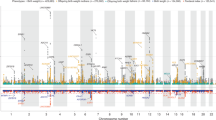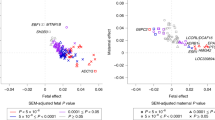Abstract
This study was designed to test the hypothesis that polymorphic variation in maternally transmitted foetal H19 alleles is associated with offspring size at birth and alterations in maternal glucose concentrations in pregnancy. Inferred parent of origins of transmitted alleles from 13 haplotype tag SNPs in the H19 gene region from 845 family (mother, partner, offspring) trios from the prospective Cambridge Baby Growth Study and 315 trios from the retrospective Cambridge Wellbeing Study cohorts were tested for association with offspring size at birth measures, as well as maternal glucose concentrations 1 h after a glucose load at week 28 of pregnancy. The foetal rs2071094 allele inherited from the mother was associated with increased birth weight (p = 0.0015) adjusted for gestational age, parity and sex. In the Cambridge Baby Growth Study it was also associated with increased head circumference (p = 0.004), length (p = 0.017) and sum of skinfold thicknesses (p = 0.017) at birth. In contrast to these results there was no association between offspring birth weight and either the maternal rs2071094 genotype or the foetal allele from the father. None of the foetal alleles or maternal genotypes were associated with maternal glucose concentrations, neither were there any other associations with offspring birth weight. In conclusion, consistent with imprinting, common polymorphic variation in foetal H19 alleles transmitted only from the mother are associated with birth weight and other markers of size at birth. Polymorphic variation in H19 is not associated with significant changes in maternal glucose tolerance in the third trimester of pregnancy.


Similar content being viewed by others
References
Adkins RM, Somes G, Morrison JC, Hill JB, Watson EM, Magann EF, Krushkal J (2010) Association of birth weight with polymorphisms in the IGF2, H19 and IGF2R genes. Pediatr Res 68:429–434
Alders M, Bliek J, vd Lip K, vd Bogaard R, Mannens M (2009) Determination of KCNQ1OT1 and H19 methylation levels in BWS and SRS patients using methylation-sensitive high-resolution melting analysis. Eur J Hum Genet 17:467–473
Barrett JC, Fry B, Maller J, Daly MJ (2005) Haploview: analysis and visualization of LD and haplotype maps. Bioinformatics 21:263–265
Carter KW, McCaskie PA, Palmer LJ (2006) JLIN: a java based linkage disequilibrium plotter. BMC Bioinformatics 7:60
Chapman J, Whittaker J (2008) Analysis of multiple SNPs in a candidate gene or region. Genet Epidemiol 32:560–566
Demars J, Shmela ME, Rossignol S, Okabe J, Netchine I, Azzi S, Cabrol S, Le Caignec C, David A, Le Bouc Y, El-Osta A, Gicquel C (2010) Analysis of the IGF2/H19 imprinting control region uncovers new genetic defects, including mutations of OCT-binding sequences, in patients with 11p15 fetal growth disorders. Hum Mol Genet 19:803–814
Dunger DB, Petry CJ, Ong KK (2007) Genetics of size at birth. Diabetes Care 30(Suppl 2):150–155
Gabory A, Ripoche MA, Yoshimizu T, Dandolo L (2006) The H19 gene: regulation and function of a non-coding RNA. Cytogenet Genome Res 113:188–193
Gabory A, Ripoche MA, Le Digarcher A, Watrin F, Ziyyat A, Forné T, Jammes H, Ainscough JF, Surani MA, Journot L, Dandolo L (2009) H19 acts as a trans regulator of the imprinted gene network controlling growth in mice. Development 136:3413–3421
Gabory A, Jammes H, Dandolo L (2010) The H19 locus: role of an imprinted noncoding RNA in growth and development. Bioessays 32:473–480
Haig D (1993) Genetic conflicts in human pregnancy. Q Rev Biol 68:495–532
Haig D (1996) Placental hormones, genomic imprinting, and maternal–fetal communication. J Evol Biol 9:357–380
Leighton PA, Ingram RS, Eggenschwiler J, Efstratiadis A, Tilghman SM (1995) Disruption of imprinting caused by deletion of the H19 gene region in mice. Nature 375:34–39
Matouk IJ, Mezan S, Mizrahi A, Ohana P, Abu-Lail R, Fellig Y, Degroot N, Galun E, Hochberg A (2010) The oncofetal H19 RNA connection: hypoxia, p53 and cancer. Biochim Biophys Acta 1803:443–451
Ong KK, Diderholm B, Salzano G, Wingate D, Hughes IA, MacDougall J, Acerini CL, Dunger DB (2008) Pregnancy insulin, glucose, and BMI contribute to birth outcomes in nondiabetic mothers. Diabetes Care 31:2193–2197
Ong KK, Langkamp M, Ranke MB, Whitehead K, Hughes IA, Acerini CL, Dunger DB (2009) Insulin-like growth factor I concentrations in infancy predict differential gains in body length and adiposity: the Cambridge Baby Growth Study. Am J Clin Nutr 90:156–161
Parra EJ, Marcini A, Akey J, Martinson J, Batzer MA, Cooper R, Forrester T, Allison DB, Deka R, Ferrell RE, Shriver MD (1998) Estimating African American admixture proportions by use of population-specific alleles. Am J Hum Genet 63:1839–1851
Petry CJ (2010) Gestational diabetes: risk factors and recent advances in its genetics and treatment. Br J Nutr 104:775–787
Petry CJ, Ong KK, Barratt BJ, Wingate D, Cordell HJ, Ring SM, Pembrey ME, Reik W, Todd JA, Dunger DB, ALSPAC Study Team (2005) Common polymorphism in H19 associated with birthweight and cord blood IGF-II levels in humans. BMC Genet 6:22
Petry CJ, Ong KK, Dunger DB (2007) Does the fetal genotype affect maternal physiology during pregnancy? Trends Mol Med 13:414–421
Petry CJ, Evans ML, Wingate DL, Ong KK, Reik W, Constância M, Dunger DB (2010) Raised late pregnancy glucose concentrations in mice carrying pups with targeted disruption of H19Δ13. Diabetes 59:282–286
Simmons RA (2009) Developmental origins of adult disease. Pediatr Clin North Am 56:449–466
Tippett LHC (1931) The Methods of Statistics, 1st edn. Williams and Norgate, London
Wangler MF, Chang AS, Moley KH, Feinberg AP, Debaun MR (2005) Factors associated with preterm delivery in mothers of children with Beckwith–Wiedemann syndrome: a case cohort study from the BWS registry. Am J Med Genet A 134A:187–191
Acknowledgments
The genotyping and placental RNA work described in this manuscript was funded by the Evelyn Trust. Core funding for other aspects of the Cambridge Baby Growth Study and Cambridge Wellbeing Study has come from the Medical Research Council, the European Union Framework 5, the World Cancer Research Fund, Newlife Birth Defects, the Mothercare Group Foundation and Wellbeing of Women. We thank all the families in the Cambridge Baby Growth and Wellbeing Studies, research nurses, staff at the Addenbrooke’s Wellcome Trust Clinical Research Facility, the Cambridge National Institute of Health Research Biomedical Research Centre and midwives at the Rosie Maternity Hospital.
Conflict of interest
The authors declare that they have no conflict of interest.
Author information
Authors and Affiliations
Corresponding author
Rights and permissions
About this article
Cite this article
Petry, C.J., Seear, R.V., Wingate, D.L. et al. Maternally transmitted foetal H19 variants and associations with birth weight. Hum Genet 130, 663–670 (2011). https://doi.org/10.1007/s00439-011-1005-x
Received:
Accepted:
Published:
Issue Date:
DOI: https://doi.org/10.1007/s00439-011-1005-x




